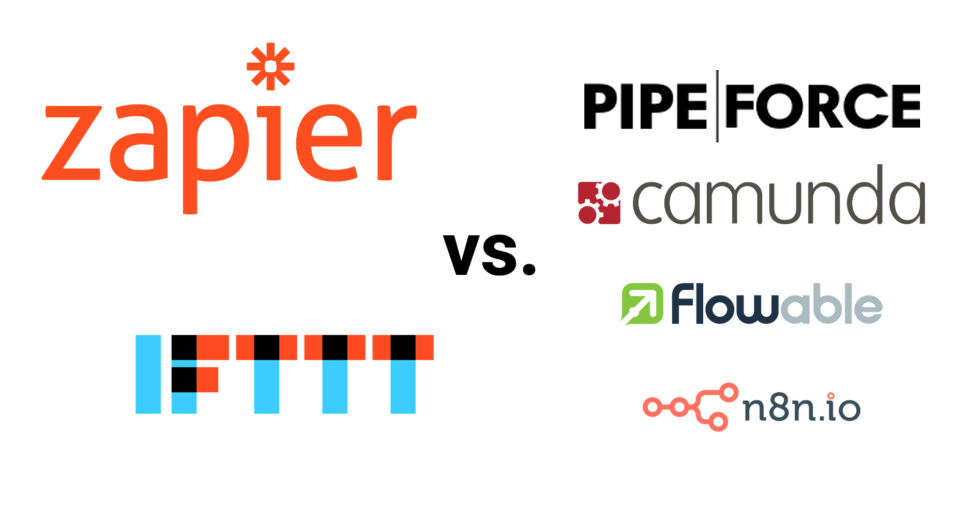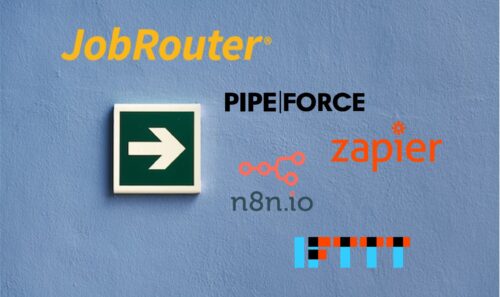
Workflow automation: 4 open source alternatives
For workflow automation, users often turn to foreign solutions like Zapier or IFTTT. But there are also alternatives that are much more open and partly available as open source variants. These generally make more sense for mid-sized and large companies.
Alternatives to IFTTT, Zapier & Co.
The great advantage of IFTTT and Zapier is their simplicity for the end user: here an Excel document is stored in Dropbox, there the pictures from Instagram are sent by e-mail. Everything is extremely easy to do. However, IT departments regularly throw up their hands in disbelief at the lack of compliance and services for integration into their own IT processes. Existing alternatives such as Camunda, Flowable, n8n and PIPEFORCE can help.
4 open solutions for workflow automation – overview:
- Camunda
- Flowable
- n8n
- PIPEFORCE
Ultimately, there are three reasons why an alternative and open solution for workflow automation can be used in companies:
- On the one hand, there is no longer any binding to a proprietary manufacturer (vendor lock-in). So you are less dependent on one provider.
- Secondly, Zapier and IFTTT in particular are not primarily designed for use in medium-sized and large companies. Integrations with the company’s own IT systems and adherence to compliance regulations are generally much easier with open systems.
- Last but not least, the server location also plays an important role. Because only with a server location in Germany does the automation also fulfill all aspects of the DSGVO.
1. camunda
Camunda is especially suitable for the automation of business processes. It is a fork of the open source software Activiti, executes processes defined in BPMN 2.0, and can be administered and monitored via a web interface. Unlike IFTTT or Zapier, Camunda is not primarily intended for end users and does not come with ready-made interfaces to cloud services. Instead, it is used as a central workflow system by a large number of companies in Germany, especially in the insurance, banking and telecommunications industries. In these areas, it provides important functions, such as substitution rules and historization. However, the hurdle for entry is correspondingly high – Camunda requires extensive knowledge of BPMN, programming and operation.
2. flowable
Similar to Camunda, Flowable also relies on the industry standard BPMN 2.0 for modeling processes. And just like Camunda, Flowable is a fork of the open-soure software Activiti. It describes itself as an open source “workflow engine” that specializes primarily in customer contact automation. Above all, the manufacturer promises smooth customer service through the use of Flowable. Flowable is also not designed for direct use by the end user. In order to model workflows and put them into operation, experts are needed to implement and operate the flowcharts, forms and corresponding logic.
3. n8n
A slightly different approach is taken by n8n (Nodemation). It is aimed primarily at end users who want to model their processes themselves, and thus comes closest to what IFTTT and Zapier offer. The JavaScript-based application already has numerous interfaces for cloud service integrations on offer. However, n8n should not be seen as a complete business process engine for automating business-critical applications. For example, concepts for scaling, failover, history or substitution rules are not implemented or not fully implemented. Furthermore, according to the official definition, n8n is not really open source: Although the source code can be viewed, the software can only be integrated into one’s own projects and products free of charge under very limited conditions.
4. PIPEFORCE
PIPEFORCE’s workflow automation and integration platform is specifically designed to meet the documentation, auditing, compliance and reporting needs of mid-sized and large enterprises. The platform integrates various open source solutions and PIPEFORCE’s own developments into a comprehensive solution for describing, creating and operating automated workflows. With the worldwide unique pipeline approach, different operations, such as the processing of messages and system triggers, the reading, writing, mapping and transforming of data or the sending of notifications, are mapped and linked in a simple application language via low code. The integration of systems (on premise and cloud) is also mapped using this approach. Developers and low-code developers thus achieve very high speed in the creation and rollout of apps and automated workflows. Due to its open design, the platform allows the connection of various systems and self-developed applications. In addition, it is also possible to develop your own commands directly on the platform and include them in workflows.
Workflow Automation – Conclusion
Automation tools like Zapier or IFTTT are becoming more and more popular. And not without reason: they are easy to use and usually have a considerable number of integrations. However, they can only cover the requirements of medium-sized and large companies to a limited extent. Here it is worth taking a look at the ever-growing number of good open source alternatives.
Test PIPEFORCE directly and without obligation! Create a free account with PIPEFORCE within seconds and start creating your automation right away!






